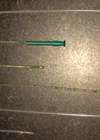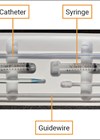Urethral catheterisation is a common procedure performed by health professionals across different grades and specialties in a variety of clinical settings. An estimated 15-25% of hospitalised patients have a urinary catheter inserted during their inpatient stay and up to 13% of nursing home patients undergo regular changes of long-term urinary catheters [1].
Indeed, clinicians rely on urinary catheters for management of urinary retention, for urine output measurement in critically ill or postoperative patients, and for urinary drainage after certain urological procedures. Despite forming an integral part of contemporary medical care, urinary catheters have significant shortcomings. A concerted effort over many years has been made to reduce the incidence of catheter-associated urinary tract infection (CAUTI). In comparison, very little attention has been directed towards the well-recognised complication of catheterisation-associated urethral injury (CAUI).
Improper catheterisation technique is a major contributor to CAUI and the implementation of education programmes has been shown to reduce but not eliminate occurrence. The ubiquitous Foley urethral catheter, largely unmodified in its design for over 80 years, has no inbuilt safeguards to prevent CAUI. Therefore, there is currently significant interest in catheter re-design to guarantee safe atraumatic urethral catheter insertion. In this brief review of CAUI, we will discuss the extent of the problem and highlight the importance of combating the issue with educational initiatives combined with urinary catheter design innovations.
The extent of the CAUI problem
Urologists are familiar with the clinical scenario of a difficult or failed male urethral catheter placement with associated bleeding or pain [2]. Multiple attempts at catheterisation are often made prior to urology involvement and the situation can be stressful and traumatic for patients and healthcare staff alike. CAUI in men is a common reason to consult inpatient urology services, accounting for 6% of all inpatient urology referrals in one study [3]. A prospective audit over a six-month period determined that CAUI occurs with an incidence of 13.4 per 1000 male urethral catheterisations [4].
“CAUI in men is a common reason to consult inpatient urology services“
The male urethra is vulnerable to injury during catheterisation due to its length, tortuosity and the presence of pathological states such as benign prostatic hyperplasia, urethral stricture and prior urological surgery. The majority of difficult male catheterisation scenarios, even with associated CAUI, can be salvaged by urology staff without the need of endoscopic intervention [2,5]. This suggests that improper catheterisation technique, compounded by the challenges of male urethral anatomy and benign prostatic enlargement, are the main underlying reasons for traumatic catheterisation by non-urological staff, rather than urethral stricture. There are two main mechanisms for CAUI during catheter insertion: i) inadvertent inflation of the catheter anchoring balloon in the urethra; ii) creation of a urethral false passage by applying too much force with the catheter tip (usually in the bulbar or prostatic urethra) [4].
The most common underlying reason why a urethral catheter does not slide into the bladder is age-related prostatic enlargement, followed by undiagnosed urethral stricture or anxiety-related urethral sphincter spasm in awake patients who are unable to relax during the catheterisation procedure. In all scenarios, the operator would feel resistance as the catheter encounters the anatomical or functional obstruction.
Additionally, CAUI can be inflicted by traumatic catheter self-removal with the balloon intact. Self-removal of a urethral catheter is typically accidental but can also be a deliberate action by a patient with altered mental status [2]. Accidental self-removal of a urethral catheter with an inflated balloon is estimated to occur in 5% of ITU patients [6].
Anecdotally, this risk is increased if the catheter is fixed inappropriately to the patient’s upper thigh. Each time a patient moves his leg, the catheter balloon irritates and pulls on the bladder neck causing pain and bladder spasm. The best thing is to avoid direct catheter fixation and allow the catheter shaft to be mobile, while ensuring safe anchorage of a frequently emptied urine bag to a urine bag stand or applying a leg-bag which can be strapped to the patient’s leg. Local practice governs which healthcare providers are primarily responsible for performing male urethral catheterisation.
Typically, nurses and doctors of all experience levels may be called upon to attempt urethral catheterisation in both inpatient and outpatient settings. Some studies suggest that the majority of CAUIs occur during catherisation by trainees during their first six months [3,7], whereas other series implicate more senior medical staff (e.g. senior house officers, registrars, general practitioners) [8,9]. Understanding local practice patterns is important to guide the introduction of targeted educational programmes to reduce CAUI.
CAUI is a preventable source of patient morbidity and also places a significant financial burden on the healthcare system. In their prospective audit of 37 cases of CAUI, Davis et al. found that 81% of patients suffered serious complications (≥ Clavien Dindo 2) such as urosepsis requiring inotropes in ITU, severe haematuria requiring blood transfusion and the need for invasive urological intervention [10]. The additional cost incurred during acute management of the 37 cases of CAUI was €335,377 (approximately €9000 per case) [10]. Cost analysis considered factors such as increased length of stay, ITU admission, procedural costs and urological resource utilisation.
The same group of 37 patients was prospectively followed (mean follow-up 37 months) to assess long-term outcomes [4]. During follow-up, 29 patients (78%) developed radiological or cystoscopic evidence of urethral stricture requiring intervention. The limitation of this observational study was that some patients may have had an undiagnosed history of urethral stricture to explain their initial traumatic catheterisation. CAUI also has medicolegal implications because it is an avoidable complication of urethral catheterisation. Cases of CAUI have been described in the medicolegal literature and are often decided in favour of the patient [11].
Educational initiatives to prevent CAUI
Educational initiatives aim to reduce the incidence of CAUI by teaching correct catheterisation technique and promoting judicious use of urethral catheters. Available evidence suggests that training and supervision of junior doctors in urethral catheterisation is inadequate [3,12]. Thomas et al. surveyed 50 new interns commencing at their institution and found that only one-third felt confident about performing urethral catheterisation [3]. Indeed, 76% of interns believed their practical training was non-existent or inadequate and 52% did not receive any senior supervision during their first urethral catheterisation procedure [3].
In contrast, Manalo et al. reported higher levels of confidence in their cohort of 225 interns, with 66% responding that they had adequate practical training and 90% being supervised during their first urethral catheterisation procedure [12]. Nevertheless, concerning gaps were identified on assessment of the cohort’s knowledge about proper urethral catheterisation technique. For example, 15% of interns reported that they do not insert the catheter to the hub prior to balloon inflation, a practice which is known to cause CAUI [12]. Additionally, urethral catheters are commonly inserted in the hospital setting for inappropriate indications, thus exposing patients unnecessarily to the risk of sustaining CAUI [1]. Education should also focus upon teaching rational and appropriate use of urethral catheters in hospitalised patients.
“CAUI is a preventable source of patient morbidity and also places a significant financial burden on the healthcare system”
Several studies suggest that education programmes for practitioners that undertake urethral catheterisation can decrease the incidence of CAUI. The implementation of a mandatory institution-wide nursing education initiative by Kashefi et al. resulted in a 4.9-fold reduction in CAUI incidence [2]. In the post-education phase of the study, CAUI occurred with an incidence of 0.7 per 1000 male admissions to hospital, compared with 3.2 per 1000 in the pre-education phase. The comprehensive nursing education programme involved a one-hour didactic component and a two-hour practical simulation module [2]. Educational posters were prominently displayed at every nursing station and outlined proper catheterisation technique by the ‘H.U.B.’ mnemonic (1. Hub – insert catheter to the hub; 2. Urine – wait for urine to return; 3. Balloon – inflate balloon with sterile water and secure catheter to leg) [2].
Similarly, Sullivan et al. decreased CAUI incidence by introducing a compulsory training course for newly qualified doctors, prior to starting their intern year [7]. The education programme delivered both didactic (two hours) and practical (two hours) modules about catheter insertion technique. Compared to an historic cohort, interns who completed the education programme reported increased confidence (from 35-65%) and increased satisfaction with the adequacy of their theoretical teaching (from 16-53%) and practical training (from 40-70%) [7]. Prior to implementing the education programme, 6% of all urological consults were for CAUI and this was reduced to 4% [7]. Additionally, the proportion of CAUI attributable to interns in their first six months fell from 71% to 44% [7].
In contrast, a similar educational initiative targeted at interns and nurses by Bhatt et al. did not have any significant impact on CAUI incidence [9]. Bhatt et al. observed that most CAUIs in their institution were sustained during catheterisation by senior doctors such as SHOs, registrars and general practitioners. Therefore, it is not surprising that a programme involving interns and nurses did not produce a reduction in CAUI incidence at their institution [9]. This study highlights the significant barriers to implementation of educational programmes to combat CAUI. Urethral catheterisation is performed by such a diverse group of health professionals of all seniority levels, thus posing a logistical challenge to training efforts [13]. In order to be maximally effective, educational programmes must be compulsory for all healthcare professionals who perform urethral catheterisation, irrespective of grade. However, compared with junior doctors and nursing staff, there are fewer available platforms for engagement with senior medical staff [9].
In many published CAUI series, a common indication for urethral catheter insertion is monitoring urine output for acute medical illness, which is not necessary unless the patient is critically unwell [3]. Indeed, inappropriate use of urethral catheters in the hospital setting is a widespread problem [1]. In one observational study, less than half of urethral catheters placed in hospitalised elderly patients had an appropriate indication [14]. Protocols that limit the indications for urethral catheterisation in hospitalised patients have been one of the mainstays of CAUTI prevention [1]. Promoting the judicious and appropriate use of urethral catheters would also be expected to have a significant impact on reducing CAUI incidence. Reported interventions to minimise placement of urethral catheters in acute care patients include various combinations of indication checklists (paper or electronic), use of bladder scanners, weighing incontinence pads for fluid output measures and education programmes [1].
Innovations in catheter design to prevent CAUI
Design innovation to improve the safety profile of the Foley urinary catheter is a critical step in combating CAUI. Although the combination of education and judicious use of urinary catheters can reduce the incidence of CAUI, urethral catheterisation remains operator dependent. Therefore, eradication of CAUI demands modification of the Foley urinary catheter design to introduce safety features that ensure atraumatic insertion.
One of the inherent design flaws of the Foley urinary catheter is that inflation of the retention balloon can generate pressures (>700kPa) well above the threshold necessary for urethral rupture (>150kPa) [15]. This directly contributes to CAUI in cases of inadvertent balloon inflation within the urethra. Therefore, there has been interest in developing safety mechanisms that prevent excessive balloon inflation pressures, with the aim of reducing CAUI due to balloon inflation injury. Class Medical has developed the TUC Safety Valve™ (Trans-urethral Catheter Safety Syringe™ valve). The TUC Safety Valve™ device is a pressure valve that connects between a standard syringe and any commercial urinary catheter balloon inflation hub. If attempts are made to inflate the catheter balloon within the urethra, the TUC Safety Valve™ valve is activated above its safety threshold pressure and decants fluid out of the system. This prevents inadvertent balloon inflation within the urethra and thus limits potential for CAUI. Davis et al. evaluated the TUC Safety Valve™ valve in a study population of 100 male patients [15].
“Eradication of CAUI demands modification of the Foley urinary catheter design to introduce safety features that ensure atraumatic insertion”
The device was used by 34 clinicians and activated in seven patients during attempted catheterisation, indicating that the catheter was incorrectly positioned with the balloon in the urethra. Interestingly, in these seven patients, the clinician was able in all cases to successfully advance the catheter into the bladder and inflate the balloon in the correct position. Based on similar principles, Safe Medical Designs, Inc. has developed its patented Signal Catheter™ [16]. The catheter design has an external ‘pilot-balloon’ along the inflation port, which off-loads fluid from the retention balloon if it is subject to high filling pressures (i.e. inadvertently inflated within the urethra), thus protecting the urethra from injury. Filling of the ‘pilot-balloon’ during a catheterisation attempt signals to the clinician that the balloon is misplaced within the urethra. The Signal Catheter™ has been the subject of bench-top and cadaveric studies. Currently, the Signal Catheter™ is FDA approved but is not CE marked and so is not available outside the United States.
Another mechanism for CAUI is accidental or deliberate extraction of the catheter with the retention balloon fully inflated. Azar et al. [17] have designed the patented Atraumatic Urinary Catheter (AUC) to address this issue. The AUC has a safety mechanism incorporated within its shaft. The shaft is composed of proximal and distal segments, with an intussuscepting junction located within the balloon cuff. If the AUC is forcibly pulled, the proximal and distal segments disengage from one another and empty the balloon fluid into the drainage lumen of the catheter. The pressure range required to trip the AUC’s safety feature can be predetermined during the manufacturing process. The AUC has been evaluated in a rabbit model, which found that forcible extraction of the AUC with the balloon inflated led to fewer and less severe cases of CAUI, compared with a standard Foley catheter [17].
Standard Foley urinary catheter design does not address any of the common underlying reasons for difficult male urethral catheterisation and subsequent CAUI, such as benign prostatic enlargement. Coudé tip and Tieman tip catheters or metal introducers can be used to negotiate an enlarged prostate, but these techniques risk exacerbating CAUI especially if false passages are already present after failed catheterisation attempts. These techniques are particularly dangerous in patients where an unknown urethral stricture is the underlying problem, as they will undermine the stricture and risk urethral perforation at the stricture segment with the risk of urethral abscess formation and urinary sepsis, or even adjacent rectal injury in extreme cases.
Contemporary urological algorithms for troubleshooting difficult male urethral catheterisation include passage of a Foley urinary catheter over a hydrophilic Nitinol guidewire (Seldinger technique) [5]. In the vast majority of difficult catheterisation cases, even in the presence of false passages or urethral stricture, the safe hydrophilic Nitinol guidewire will find its way blindly into the bladder [5]. In a recent study, over 90% of difficult male urethral catheter cases referred to urology were successfully placed by non-urologically trained doctors using the blind Seldinger technique [5]. Urethrotech Ltd has developed and patented the Urethral Catheterisation Device (UCD®), which is the first urinary catheter on the market to incorporate an integrated hydrophilic Nitinol guidewire into its design [18]. The UCD® makes the safe and effective Seldinger technique easily accessible and available to non-urologists, who are the frontline staff responsible for the majority of urethral catheterisations.
The UCD® is an ideal second-line urethral catheter, when catheterisation with a standard Foley catheter has been unsuccessful. The National Institute for Health and Care Excellence (NICE) in the UK has endorsed the UCD® as cost-effective for this indication. The safety and efficacy of the UCD® has been evaluated in different patient populations including elective cardiac surgery patients, nurse-led outpatient trial without catheter (TWOC) clinics and patients undergoing reconstructive urology surgery. In a prospective observational cohort study, UCD® catheterisation was compared to standard Foley-catheterisation in men undergoing elective cardiac surgery [18]. No patients in the UCD® group (n=100) had failed or traumatic urethral catheterisation. In contrast, in the Foley catheter group (n=74) there were two cases of failed urethral catheterisation (requiring suprapubic catheter insertion) and three cases of CAUI.
Conclusion
CAUI is a preventable injury that causes significant patient morbidity and incurs substantial financial cost. As urologists, we must take a leadership role in the fight against CAUI. We must actively support educational initiatives that promote judicious use of urinary catheters and teach correct catheterisation technique. Urologists must embrace the translation of urinary catheter design innovation into clinical practice and support researchers and medical device companies in their efforts to design safer urethral catheters to eliminate CAUI.
References
1. Loveday HP, Wilson JA, Pratt RJ, et al. epic3: national evidence-based guidelines for preventing healthcare-associated infections in NHS hospitals in England. J Hosp Infect 2014;86 Suppl 1:S1-70.
2. Kashefi C, Messer K, Barden R, et al. Incidence and prevention of iatrogenic urethral injuries. J Urol 2008;179(6):2254-7.
3. Thomas AZ, Giri SK, Meagher D, Creagh T. Avoidable iatrogenic complications of urethral catheterization and inadequate intern training in a tertiary-care teaching hospital. BJU Int 2009;104(8):1109-12.
4. Davis NF, Bhatt NR, MacCraith E, et al. Long-term outcomes of urethral catheterisation injuries: a prospective multi-institutional study. World J Urol 2019 [Epub ahead of print].
5. Yuminaga Y, Kam J, Louie-Johnsun M. Multi-centre, prospective evaluation of the Seldinger technique for difficult male urethral catheter insertions by non-urology trained doctors. BJU Int 2017;120 Suppl 3:21-7.
6. Wu AK, Blaschko SD, Garcia M, et al. Safer urethral catheters: how study of catheter balloon pressure and force can guide design. BJU Int 2012;109(7):1110-14.
7. Sullivan JF, Forde JC, Thomas AZ, et al. Avoidable iatrogenic complications of male urethral catheterisation and inadequate intern training: a 4-year follow-up post implementation of an intern training programme. Surgeon 2015;13(1):15-18.
8. Bhatt NR, Davis NF, Addie D, et al. Evaluating the cost of iatrogenic urethral catheterisation injuries. Ir J Med Sci 2017;186(4):1051-5.
9. Bhatt NR, Davis NF, Quinlan MR, et al. A prospective audit on the effect of training and educational workshops on the incidence of urethral catheterization injuries. Can Urol Assoc J 2017;11(7):E302-E306.
10. Davis NF, Quinlan MR, Bhatt NR, et al. Incidence, cost, complications and clinical outcomes of iatrogenic urethral catheterization injuries: a prospective multi-institutional study. J Urol 2016;196(5):1473-7.
11. Awad MA, Osterberg EC, Chang H, et al. Urethral catheters and medical malpractice: a legal database review from 1965 to 2015. Transl Androl Urol 2016;5(5):762-73.
12. Manalo M, Lapitan MC, Buckley BS. Medical interns’ knowledge and training regarding urethral catheter insertion and insertion-related urethral injury in male patients. BMC Medical Education 2011;11:73.
13. Simhan J. Reducing iatrogenic urethral trauma. J Urol 2015;194(4):871-2.
14. Gokula RM, Smith MA, Hickner J. Emergency room staff education and use of a urinary catheter indication sheet improves appropriate use of foley catheters. Am J Infect Control 2007;35(9):589-93.
15. Davis NF, Cunnane EM, Mooney RO, et al. Clinical evaluation of a safety-device to prevent urinary catheter inflation related injuries. Urology 2018;115:179-83.
16. Zhao H, Aaronson D, Garcia M. A novel urethral catheter design to both prevent and minimize morbidity with intra-urethral catheter injury (IUCI). Presented at AUA Annual Meeting, San Francisco; 2018.
17. Azar R, Shadpour P. In vivo trial of a novel atraumatic urinary catheter design for prevention of catheter-induced trauma. J Endourol 2016;30(7):822-7.
18. Bugeja S, Mistry K, Yim IHW, et al. A new urethral catheterisation device (UCD) to manage difficult urethral catheterisation. World J Urol 2019;37(4):595‑600.
Declaration of competing interests: None declared.









